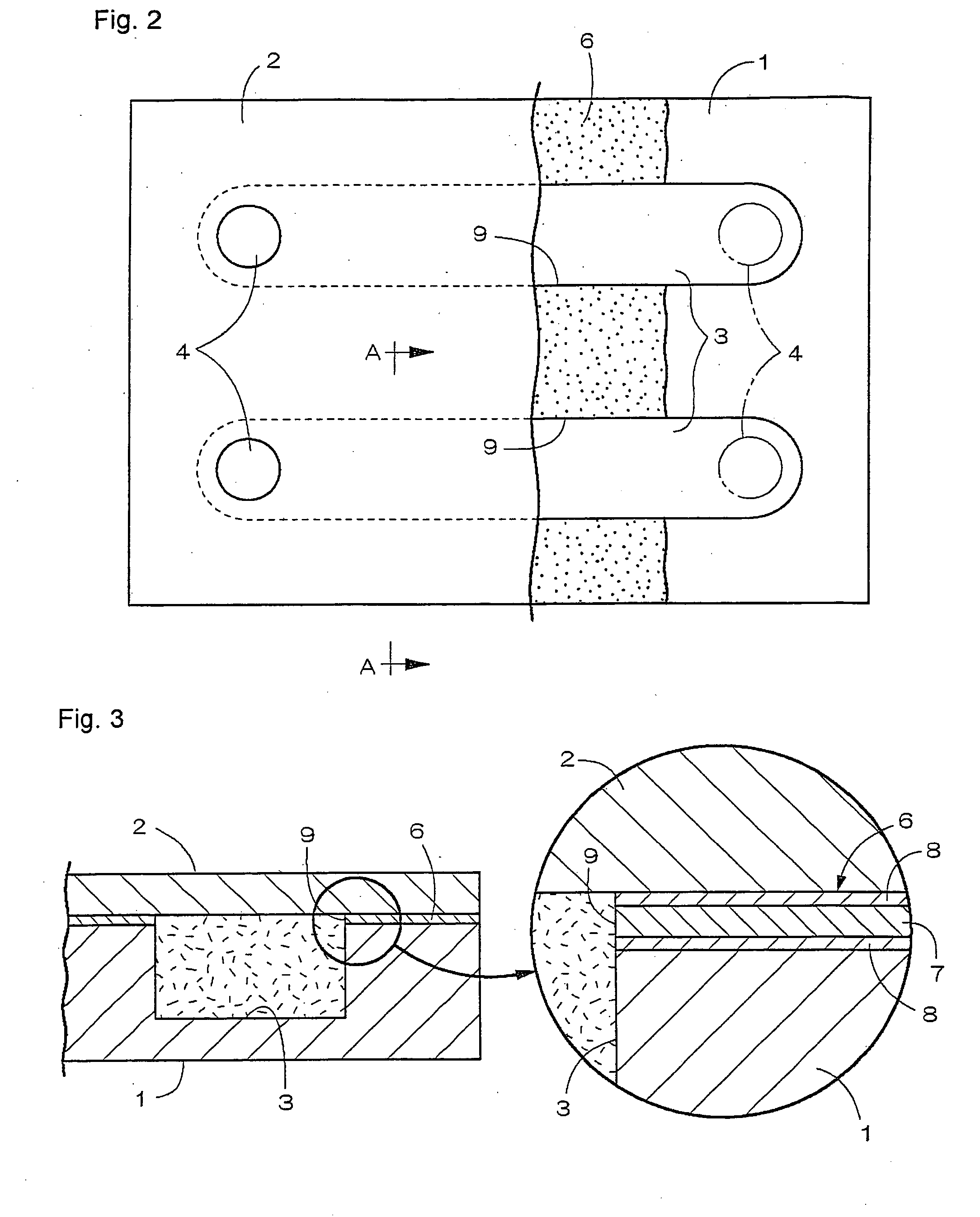Fluid vessel
a technology of flue gas and cylinder, which is applied in the field of flue gas vessels, can solve the problems of inability to negligible safety matters, difficult to apply flue gas uniformly with a selected thickness, and forming unwanted spaces around the periphery, etc., and achieves convenient operation, good reliability, and less trouble.
- Summary
- Abstract
- Description
- Claims
- Application Information
AI Technical Summary
Benefits of technology
Problems solved by technology
Method used
Image
Examples
example 1
[0109] With reference to FIGS. 1 to 3, Example 1 of the fluid vessel (for example, a reaction vessel) according to the present invention which corresponds to the first aspect will be explained. It is noted that FIG. 1 schematically shows a perspective view of the fluid vessel in its exploded state, FIG. 2 schematically shows a plan view of the fluid vessel while a part thereof is cut away, and FIG. 3 schematically shows a cross-sectional view of a portion of the fluid vessel along a line A-A in FIG. 2. The fluid vessel of Example 1 comprises a base member 1 and a cover plate 2 which is bonded to the base member 1.
[0110] The base member 1 is formed into a plate form which defines a planar area and of which thickness dimension is relatively smaller than the other dimensions. The base member 1 has an elongated rectangular shape in its projected planar view. The base member 1 may be formed by using for example a borosilicate glass, a quartz glass or a resin such as a polydimetylsiloxan...
example 2
[0122] With reference to FIGS. 4 to 6, Example 2 of the fluid vessel (for example, a reaction vessel) according to the present invention which corresponds to the second aspect will be explained. It is noted that FIG. 4 schematically shows a perspective view of the fluid vessel in its exploded state, FIG. 5 schematically shows a plan view of a portion of the fluid vessel, and FIG. 6 schematically shows a perspective view of a stencil plate which is used for the formation of an adhesive layer. In Example 2, since the base member 1 and the cover plate 2 which is boned to the base member 1 are substantially the same as those in Example 1, the same reference numbers as in Example 1 are used to indicate the same members as in Example 1, and explanations of them are omitted here. It is noted that a whole of the cover plate 2 is made of a transparent material for the purpose of passing UV as explained below.
[0123] In FIGS. 4 and 5, upon the production of the fluid vessel, the base member 1...
example 3
[0130] With reference to FIGS. 7 to 10, Example 3 of the fluid vessel (for example, a reaction vessel) according to the present invention which corresponds to the second aspect will be explained. It is noted that FIG. 7 schematically shows a perspective view of the fluid vessel in its exploded state, FIG. 8 schematically shows a plan view of the fluid vessel while a part thereof is cut away, and FIG. 9 schematically shows a cross sectional view of a portion of the fluid vessel (along the line B-B in FIG. 8), and FIG. 10 schematically shows in a cross-sectional view how to carry out spot-welding. In Example 3, since the base member 1 and the cover plate 2 which is boned to the base member 1 are substantially the same as those in Examples 1 and 2, the same reference numbers as in the Examples are used to indicate the same members as in the Examples, and explanations of them are omitted here. It is noted that each of the base member 1 and the cover plate 2 is a molded article of a ther...
PUM
| Property | Measurement | Unit |
|---|---|---|
| Shape | aaaaa | aaaaa |
| Adhesivity | aaaaa | aaaaa |
| Transparency | aaaaa | aaaaa |
Abstract
Description
Claims
Application Information
 Login to View More
Login to View More - R&D
- Intellectual Property
- Life Sciences
- Materials
- Tech Scout
- Unparalleled Data Quality
- Higher Quality Content
- 60% Fewer Hallucinations
Browse by: Latest US Patents, China's latest patents, Technical Efficacy Thesaurus, Application Domain, Technology Topic, Popular Technical Reports.
© 2025 PatSnap. All rights reserved.Legal|Privacy policy|Modern Slavery Act Transparency Statement|Sitemap|About US| Contact US: help@patsnap.com



